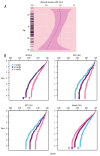A Non-Targeted Liquid Chromatographic-Mass Spectrometric Metabolomics Approach for Association with Coronary Artery Disease: An Identification of Biomarkers for Depiction of Underlying Biological Mechanisms
- PMID: 28151921
- PMCID: PMC5301958
- DOI: 10.12659/msm.896298
A Non-Targeted Liquid Chromatographic-Mass Spectrometric Metabolomics Approach for Association with Coronary Artery Disease: An Identification of Biomarkers for Depiction of Underlying Biological Mechanisms
Abstract
BACKGROUND We performed non-targeted metabolomics analysis using liquid chromatography-mass spectrometry coupled technique to explore the biological mechanism of coronary artery disease (CAD) events for improved prediction. MATERIAL AND METHODS We studied the association of CAD events in 4092 individuals and observed the replication of sphingomyelin (28:1), lysophosphatidylcholine (18:2), lysophosphatidylcholine (18:1), and monoglyceride (18:2), which were independent of main CAD risk factors. RESULTS We found that these 4 metabolites were responsible for traditional risk factors and also contributed to the modifications related to reclassification and discrimination. Monoglycerides (MonoGs) were positively associated with C-reactive proteins and body mass index, while lysophosphatidylcholines (LPPCs), which had less evidence of subclinical CAD in an additional 1010 participants, yielded a reverse pattern. An association between monoGs and CAD independence of triglycerides (triGs) were also observed. On the basis of Mendelian randomization analysis, we observed a positive but weak irregular effect (odds ratio per unit increase in standard deviation in monoG=1.11, P-value=0.05) on CAD. CONCLUSIONS Our work establishes the relationship of metabolome with coronary artery disease and explains the biological mechanism of CAD events, as we identified the above-mentioned metabolites along with the evidence supporting their clinical use.
Figures

Similar articles
-
Large-scale metabolomic profiling identifies novel biomarkers for incident coronary heart disease.PLoS Genet. 2014 Dec 11;10(12):e1004801. doi: 10.1371/journal.pgen.1004801. eCollection 2014 Dec. PLoS Genet. 2014. PMID: 25502724 Free PMC article.
-
Association of Coronary Artery Disease and Metabolic Syndrome: Usefulness of Serum Metabolomics Approach.Front Endocrinol (Lausanne). 2021 Sep 24;12:692893. doi: 10.3389/fendo.2021.692893. eCollection 2021. Front Endocrinol (Lausanne). 2021. PMID: 34630321 Free PMC article.
-
Identification of Metabolites Associated with Onset of CAD in Diabetic Patients Using CE-MS Analysis: A Pilot Study.J Atheroscler Thromb. 2019 Mar 1;26(3):233-245. doi: 10.5551/jat.42945. Epub 2018 Aug 1. J Atheroscler Thromb. 2019. PMID: 30068816 Free PMC article.
-
Mass spectrometric based approaches in urine metabolomics and biomarker discovery.Mass Spectrom Rev. 2017 Mar;36(2):115-134. doi: 10.1002/mas.21455. Epub 2015 Apr 16. Mass Spectrom Rev. 2017. PMID: 25881008 Review.
-
Biomarkers in Stable Coronary Artery Disease.Curr Pharm Biotechnol. 2017;18(6):456-471. doi: 10.2174/1389201018666170630120805. Curr Pharm Biotechnol. 2017. PMID: 28669333 Review.
Cited by
-
Effects of Puerarin on Clinical Parameters, Vascular Endothelial Function, and Inflammatory Factors in Patients with Coronary Artery Disease.Med Sci Monit. 2019 Jan 14;25:402-408. doi: 10.12659/MSM.911108. Med Sci Monit. 2019. PMID: 30636768 Free PMC article.
-
Targeted Metabolomics Shows Low Plasma Lysophosphatidylcholine 18:2 Predicts Greater Decline of Gait Speed in Older Adults: The Baltimore Longitudinal Study of Aging.J Gerontol A Biol Sci Med Sci. 2019 Jan 1;74(1):62-67. doi: 10.1093/gerona/gly100. J Gerontol A Biol Sci Med Sci. 2019. PMID: 29788121 Free PMC article.
-
Perspective: The Potential Role of Circulating Lysophosphatidylcholine in Neuroprotection against Alzheimer Disease.Adv Nutr. 2020 Jul 1;11(4):760-772. doi: 10.1093/advances/nmaa024. Adv Nutr. 2020. PMID: 32190891 Free PMC article.
-
Altered branched chain amino acid metabolism: toward a unifying cardiometabolic hypothesis.Curr Opin Cardiol. 2018 Sep;33(5):558-564. doi: 10.1097/HCO.0000000000000552. Curr Opin Cardiol. 2018. PMID: 29994805 Free PMC article. Review.
-
Multi-Omics Investigation into Acute Myocardial Infarction: An Integrative Method Revealing Interconnections amongst the Metabolome, Lipidome, Glycome, and Metallome.Metabolites. 2022 Nov 8;12(11):1080. doi: 10.3390/metabo12111080. Metabolites. 2022. PMID: 36355163 Free PMC article.
References
-
- Mercuro G, Bassareo PP, Deidda M, et al. Metabolomics: A new era in cardiology? J Cardiovasc Med (Hagerstown) 2011;12(11):800–5. - PubMed
-
- Watkins SM, German JB. Toward the implementation of metabolomic assessments of human health and nutrition. Curr Opin Biotechnol. 2002;13(5):512–16. - PubMed
-
- Shah SH, Bain JR, Muehlbauer MJ, et al. Association of a peripheral blood metabolic profile with coronary artery disease and risk of subsequent cardiovascular events. Circ Cardiovasc Genet. 2010;3:207–14. - PubMed
MeSH terms
Substances
LinkOut - more resources
Full Text Sources
Medical
Miscellaneous

